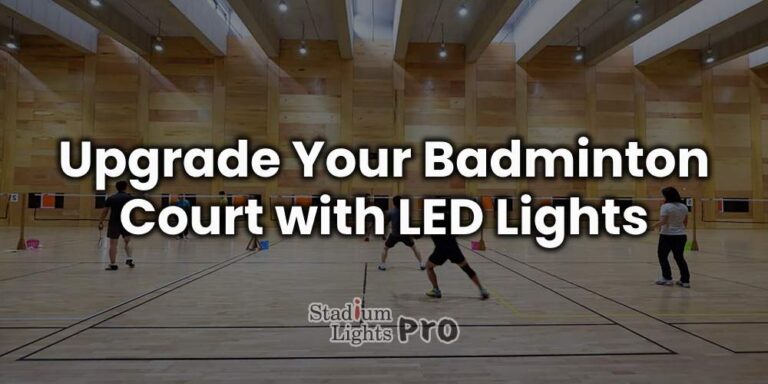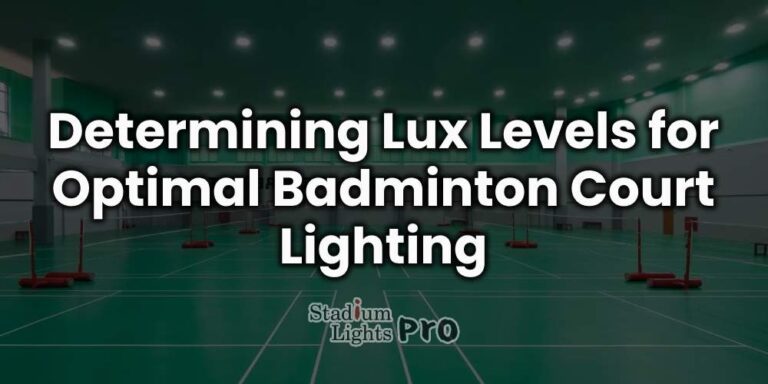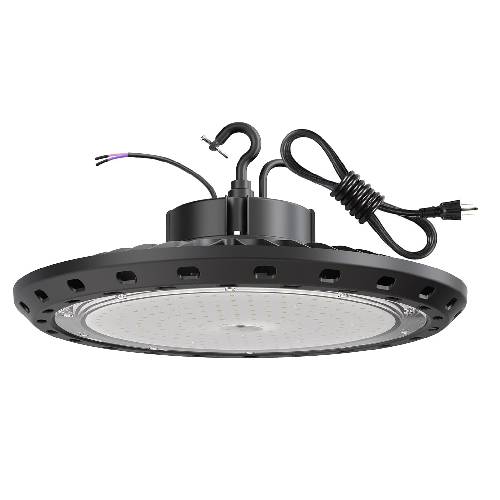
Badminton Court Lighting
Badminton is a fast-paced sport that demands precision, agility, and concentration. To ensure optimal performance and safety, the quality of lighting on the badminton court is paramount. Proper lighting not only enhances the visibility of the shuttlecock but also minimizes eye strain and shadows, providing a fair playing field. This article delves into the crucial aspects of badminton court lighting, with a special focus on LED lighting technology, which has revolutionized the way sports venues are illuminated.

The right lighting transforms a standard court into a stage where skill and strategy shine at their brightest. In the world of badminton, lighting isn’t just about visibility—it’s about creating an environment where athletes can push their limits and where every moment of the game glows with brilliance. As we explore the essentials of badminton court lighting, particularly the revolutionary impact of LED technology, you’ll discover how the perfect illumination can elevate the game, inspire excellence, and illuminate the path to victory.
Contact us for a free lighting consultation
With advancements in lighting technology, particularly with LED solutions, the standards for illuminating badminton courts have significantly improved. This article explores the essential aspects of badminton court lighting, focusing on LED technology, uniformity, lux levels, power efficiency, and solar lighting applications.
Table of Contents
ToggleImportance of Proper Lighting in Badminton
In badminton, the shuttlecock’s rapid speed and unpredictable flight path require exceptional visual clarity for both players and spectators. The shuttlecock, or birdie, can travel at speeds exceeding 200 miles per hour during competitive play, making it crucial for players to have a clear, unobstructed view of its trajectory. Any deficiencies in lighting can severely impact the game by causing visual strain, reducing players’ reaction times, and increasing the risk of errors or injuries. For instance, if lighting is uneven or too dim, players may struggle to track the shuttlecock accurately, leading to missed shots or collisions, which can compromise their performance and safety.
From a spectator’s perspective, especially in high-stakes or competitive matches, proper lighting is equally important. Inadequate lighting can detract from the enjoyment of watching the game, as it can create shadows and glare that obscure the action. For audiences, whether in a packed stadium or watching a live broadcast, clear and consistent lighting enhances the overall viewing experience by ensuring that every moment of the game is visible and engaging. This is particularly critical in professional arenas, where the quality of the viewing experience can significantly impact fan satisfaction and the sport’s reputation.
Moreover, well-lit badminton courts play a crucial role in television broadcasts and online streaming. High-quality lighting improves the clarity and color accuracy of the footage, making the game more appealing and easier to follow for viewers at home. For broadcasters, ensuring that the court is uniformly illuminated helps in capturing high-definition images and reducing the need for post-production adjustments. This not only enhances the broadcast quality but also ensures that the excitement and nuances of the game are conveyed effectively to a global audience.
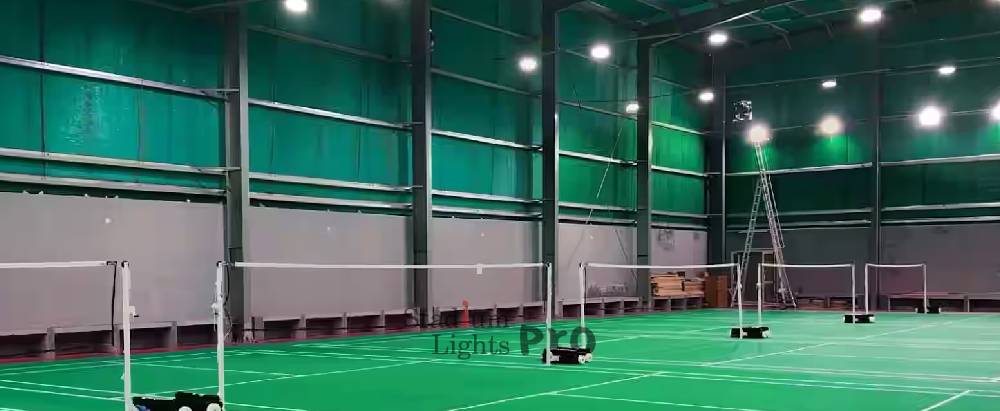
LED Design for Badminton Court
Uniformity of Light
Achieving uniform illumination is one of the most critical aspects of designing lighting for a badminton court. The speed and precision required in badminton mean that players must have a consistent and clear view of the entire court to perform at their best. Any variation in light levels—such as shadows or bright spots—can significantly impact a player’s ability to track the shuttlecock accurately, leading to potential errors and reduced performance.
Uniform illumination ensures that every part of the badminton court is evenly lit, eliminating areas of excessive brightness or darkness. This consistency is crucial because badminton involves rapid movements and split-second decisions. If certain areas of the court are brighter or dimmer than others, it can create visual distractions that hinder a player’s focus and reaction time. For instance, a bright spot on the court could make the shuttlecock difficult to see as it passes through that area, while a shadow could obscure its trajectory, leading to missed shots or inaccurate judgments.
Lux Levels and Power Efficiency
Lux is a measure of the intensity of light that reaches a surface, and achieving the appropriate lux level is essential for ensuring optimal visibility and clarity on a badminton court. For competitive play, the recommended lux level typically ranges from 500 to 1000 lux. This range ensures that the court is brightly enough lit to allow players to track the fast-moving shuttlecock with precision while minimizing visual strain. The specific lux level needed can vary based on the court’s size and the level of play, with higher lux levels often required for professional or high-stakes matches where clarity is paramount.
LED lighting technology stands out for its ability to deliver high lux levels while consuming less power compared to traditional lighting options. For instance, a 200-watt LED fixture can provide the same amount of illumination as a 400-watt metal halide lamp, effectively reducing energy consumption by half. This significant energy efficiency translates into lower operational costs and reduced environmental impact, as LEDs not only lower electricity bills but also contribute to sustainability efforts. Their long lifespan further reduces the frequency of replacements, offering additional savings and making LEDs an economically and environmentally advantageous choice for illuminating badminton courts.
Color Temperature and Visual Comfort
Color temperature, measured in Kelvin (K), plays a critical role in how light is perceived and impacts visual performance. For badminton courts, a color temperature between 4000K and 5000K is generally recommended. This range of neutral white light closely resembles natural daylight, which helps to create a visually comfortable environment for players. Neutral white light enhances contrast and detail, allowing players to better distinguish the shuttlecock against the background and reducing eye strain during intense play. It also ensures accurate color representation on the court, preventing any distortion that might otherwise affect performance.
On the other hand, light that is either too warm (lower Kelvin values) or too cool (higher Kelvin values) can lead to problems such as color distortion and glare. Warm light can make the court appear dimmer and affect players’ ability to perceive colors accurately, while cool light might produce harsh glare, making it difficult to follow fast-moving objects. LEDs provide the flexibility to select from a wide range of color temperatures, allowing lighting designers to fine-tune the illumination to match the specific needs of the badminton court. This adaptability ensures that players benefit from optimal visual clarity and comfort, tailored to enhance both their performance and overall experience.
Durability and Maintenance
Badminton courts, whether situated indoors or outdoors, face a variety of environmental conditions that demand robust and reliable lighting solutions. Indoor courts are subjected to the wear and tear of frequent use and exposure to various environmental factors such as dust and moisture. Outdoor courts, on the other hand, are exposed to more challenging conditions including temperature fluctuations, rain, and even potential impacts from wind and debris. In such scenarios, the durability and longevity of the lighting system become crucial.
LED lights are particularly well-suited to meet these demands. Known for their remarkable durability, LEDs are designed to withstand harsh conditions and have a lifespan that can extend up to 50,000 hours or more. This extended lifespan significantly reduces the frequency of replacements compared to traditional incandescent or metal halide bulbs, which often need to be replaced much sooner due to their shorter operational life and susceptibility to breakage. The sturdy construction of LEDs makes them less prone to damage from impacts or vibrations, further enhancing their reliability. Additionally, the reduced need for frequent maintenance and replacements translates into lower long-term operational costs, making LEDs a cost-effective choice for sports lighting. Their durability not only ensures consistent performance but also contributes to overall savings by minimizing maintenance efforts and associated costs, providing a resilient and economical solution for both indoor and outdoor badminton courts.
Solar Lighting Applications
The integration of solar technology with LED lighting offers a highly sustainable and environmentally friendly solution for badminton courts, especially those situated outdoors or in regions with ample sunlight. Solar-powered LED lights operate by harnessing energy from the sun through photovoltaic panels, which capture and convert sunlight into electrical energy. This renewable power source enables the lights to charge during daylight hours and illuminate the court during the night, eliminating the need for grid electricity and reducing the reliance on non-renewable energy resources. For outdoor badminton courts, particularly those in sunny areas, solar lighting not only provides consistent illumination but also contributes significantly to reducing the facility’s overall carbon footprint.
While the initial cost of installing solar-powered LED lighting systems can be higher compared to traditional lighting options, the long-term benefits far outweigh these upfront expenses. Over time, solar lighting reduces electricity costs because it relies on free solar energy rather than purchased electricity. This leads to substantial savings on utility bills. Additionally, the sustainability of solar lighting aligns with broader environmental goals by minimizing greenhouse gas emissions and promoting the use of renewable energy sources. The lower operational costs and reduced environmental impact make solar-powered LED lighting an attractive choice for badminton courts, supporting both economic efficiency and ecological responsibility.
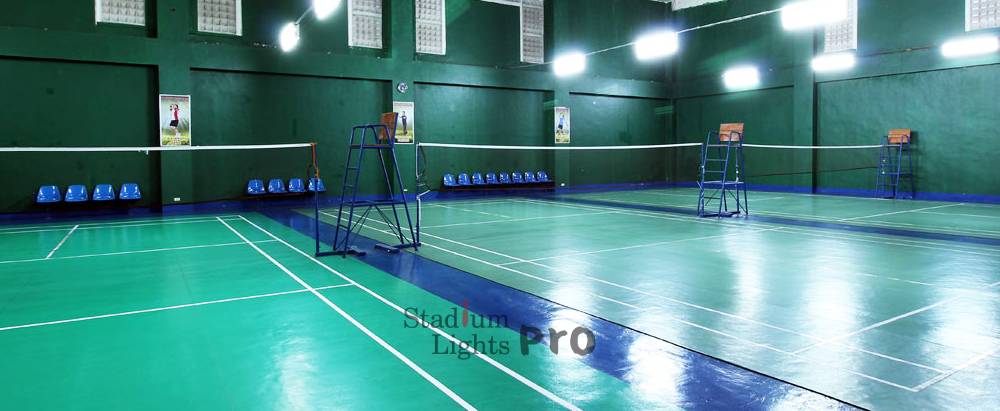
Badminton Court Lighting Placement
Lighting design is more than just selecting the right fixtures; it involves strategic placement to achieve optimal illumination. For badminton courts, the goal is to minimize shadows and glare while ensuring even light distribution.
Overhead Lighting
In indoor badminton courts, achieving optimal lighting involves careful consideration of fixture placement and height to ensure consistent illumination across the entire playing area. Lighting fixtures are typically mounted on the ceiling, with their arrangement meticulously planned to avoid creating uneven lighting patterns. The goal is to eliminate shadows and bright spots that could hinder players’ visibility and performance. Proper fixture placement is essential; fixtures need to be positioned strategically to cover the court uniformly, which involves balancing the intensity of light to prevent any areas from being overly bright or inadequately lit. This arrangement helps maintain a clear and consistent view of the shuttlecock, which is crucial for players who need to react quickly and accurately during fast-paced matches.
The height at which the lighting fixtures are mounted also plays a significant role in achieving even illumination. Fixtures that are placed too high may result in insufficient light reaching the playing surface, while those mounted too low can cause glare and excessive brightness in certain areas. The ideal height ensures that the light is dispersed effectively across the court, minimizing shadows and reducing glare. By carefully calibrating both the height and arrangement of the fixtures, indoor badminton courts can achieve a well-lit environment that enhances players’ visibility and comfort, contributing to a better overall playing experience.
Perimeter Lighting
Perimeter lighting plays a significant role in enhancing the visibility and safety of the surrounding areas of a badminton court, particularly in large sports halls or arenas. By illuminating the boundary areas beyond the court itself, perimeter lighting helps ensure that these spaces are well-lit, which is essential for player safety and spectator comfort. In expansive venues, where the court is situated in a larger area with potentially dimly lit edges or corners, adequate perimeter lighting prevents accidents by clearly defining the edges and any obstacles that might otherwise be obscured in low light. This improved visibility helps players avoid collisions with the walls or other hazards and allows them to navigate the court’s boundaries more confidently.
For spectators, perimeter lighting enhances the overall viewing experience by providing a well-lit environment around the court. This additional illumination helps reduce eye strain and enhances the aesthetic appeal of the venue. Well-lit perimeter areas contribute to a more engaging and enjoyable experience for those watching the match, as they can see the entire setting more clearly. Furthermore, perimeter lighting can be an important aspect of crowd management and safety, ensuring that emergency exits and pathways are easily visible and accessible. Overall, effective perimeter lighting not only supports player safety and enhances the spectator experience but also contributes to the overall functionality and ambiance of large sports facilities.
Adjustable Lighting
Adjustable lighting systems offer significant advantages for badminton courts by allowing for customizable changes in brightness according to specific needs and activities. These systems often feature dimmer controls and smart lighting solutions that enable users to fine-tune the light levels to suit various scenarios. For instance, during regular practice sessions, a lower brightness setting may be sufficient and help create a more relaxed atmosphere. Conversely, during competitive matches or high-profile media productions, increased brightness ensures optimal visibility and clarity for both players and viewers. This flexibility is particularly valuable in multi-purpose sports facilities where the court may host different events requiring varied lighting conditions.
Moreover, smart lighting solutions enhance this adaptability by integrating with advanced control systems that can be programmed to adjust light levels automatically based on the time of day, specific events, or user preferences. This capability allows for seamless transitions between different lighting setups without manual intervention, ensuring that the court is always optimally illuminated for its intended use. For media productions, such as live broadcasts or professional recordings, precise control over lighting can improve the quality of the footage by minimizing shadows and glare, and enhancing the visual appeal of the game. Overall, adjustable and smart lighting systems provide badminton courts with the versatility needed to accommodate diverse requirements, enhancing both the functional and aesthetic aspects of the venue.
Lighting Knowledge for Badminton Court
Light Distribution
Achieving proper light distribution on a badminton court requires meticulous planning and calculation to ensure that every area of the court is uniformly illuminated. This process involves determining the optimal number of light fixtures needed and their strategic placement to achieve consistent lighting coverage. The goal is to prevent the formation of dark zones and hot spots—areas of the court that are either too dim or excessively bright. Dark zones can obscure parts of the court, making it difficult for players to track the shuttlecock accurately and leading to potential errors or reduced performance. Conversely, hot spots can create uncomfortable glare and visual distractions, impairing players’ ability to focus and react swiftly.
To achieve this level of precision, lighting designers use advanced tools and techniques, such as computer simulations and photometric analysis, to model how light will be distributed across the court. These tools help in predicting how different fixture arrangements and types will affect illumination levels, allowing designers to adjust placements and configurations accordingly. By calculating factors such as fixture height, beam angle, and spacing, designers can ensure that light is evenly spread across the entire playing surface. This careful approach not only enhances player performance by providing clear and consistent visibility but also contributes to the overall safety and enjoyment of the game. Proper light distribution ensures that players can perform optimally, without being hindered by uneven lighting conditions.
Glare Reduction
Glare is a common issue in sports lighting that can significantly affect both player performance and spectator comfort. Glare occurs when intense light directly hits the eyes, causing visual discomfort and impairing one’s ability to see clearly. In a badminton court setting, glare can be particularly problematic as it can distract players and make it challenging for them to track the fast-moving shuttlecock. This visual disturbance not only affects the players’ focus and reaction times but can also detract from their overall performance. To mitigate glare, it is crucial to select lighting fixtures designed with features that control and direct light effectively.
One effective method to reduce glare is through the use of anti-glare shields and diffusers. Anti-glare shields are designed to block or redirect direct light that might otherwise hit players’ eyes, thereby minimizing the discomfort caused by bright light sources. Diffusers, on the other hand, spread light more evenly, reducing harsh shadows and creating a softer, more uniform illumination across the court. By integrating these components into the lighting design, the playing environment becomes more comfortable and visually pleasant for the players. This approach not only improves the quality of the game by ensuring that players can maintain their focus and performance but also enhances the overall experience for spectators, creating a more enjoyable and engaging viewing environment.
Flicker-Free Lighting
Flickering lights can have a detrimental effect on both player performance and overall visual comfort in sports settings. When lighting fixtures flicker, even subtly, they create a stroboscopic effect that can cause visual discomfort and distraction. For badminton players, this flicker can interfere with their ability to track the shuttlecock accurately, leading to reduced reaction times and potentially impacting their game. Persistent flicker can also contribute to eye strain and headaches, making it difficult for players to maintain concentration and perform at their best. This issue becomes particularly pronounced during fast-paced matches, where every visual cue needs to be clear and stable.
High-quality LED fixtures are specifically engineered to address and eliminate the problem of flickering. Unlike traditional lighting sources that may exhibit inconsistent light output, modern LEDs provide stable and continuous illumination thanks to their advanced electronic drivers and circuitry. These drivers are designed to maintain a constant light output, ensuring that the light remains steady and flicker-free. By using high-quality LED fixtures, the playing environment becomes more comfortable, reducing visual strain and allowing players to focus better on their performance. This stability not only enhances the quality of the game but also contributes to a more enjoyable experience for spectators, who benefit from clear and consistent lighting during broadcasts and live events.
Emergency Lighting
Emergency lighting systems are an essential component of any sports facility, including badminton courts, as they play a critical role in maintaining safety during power outages or other emergencies. These systems are designed to provide illumination when the main power supply fails, ensuring that the court and surrounding areas remain visible. This is crucial for facilitating safe and orderly evacuations, particularly in situations where visibility might otherwise be compromised. Emergency lighting helps guide players, spectators, and staff to exits and safe areas, reducing the risk of accidents and ensuring that everyone can evacuate the facility quickly and efficiently.
In addition to their safety function, emergency lighting systems also contribute to the overall preparedness of the facility for unexpected situations. These systems are equipped with backup power sources, such as batteries or generators, which automatically activate when there is a power interruption. By providing reliable and consistent lighting during emergencies, these systems enhance the facility’s resilience and ensure that safety protocols can be effectively implemented. This preparedness not only protects individuals within the facility but also helps to maintain compliance with safety regulations and standards. Overall, investing in robust emergency lighting systems is a vital aspect of ensuring the safety and well-being of all individuals in a sports venue.
Energy Efficiency and Sustainability
Traditional lighting systems, such as incandescent or metal halide lamps, tend to consume a considerable amount of energy, leading to higher electricity bills and greater carbon emissions. In contrast, LED lighting represents a major advancement in energy efficiency. LEDs use a fraction of the energy required by traditional bulbs to produce the same amount of light, resulting in substantial reductions in electricity consumption. This efficiency translates directly into lower operational costs, as the energy savings from LEDs can be substantial over time, making them a more economical choice for facilities aiming to manage their expenses effectively.
Furthermore, the environmental benefits of choosing LED lighting extend beyond just cost savings. Because LEDs are more energy-efficient, they contribute to a decrease in carbon emissions, which is essential for mitigating climate change. By using less energy, LEDs help reduce the demand for power from fossil fuel-based electricity generation, thereby lowering the overall carbon footprint of the facility. This aligns with broader sustainability goals and environmental stewardship efforts. For badminton courts and other sports facilities, adopting LED lighting is not only a smart financial decision but also a responsible environmental choice that supports global efforts to reduce greenhouse gas emissions and promote sustainable practices.
Frequently Asked Questions in Badminton Court Lighting
What is the recommended lux level for a badminton court?
The recommended lux level for a badminton court typically falls between 300 and 500 lux. This range is essential to provide players with the clarity needed to track the shuttlecock and respond effectively. For recreational play, 300 lux generally offers sufficient illumination, allowing for a comfortable and enjoyable experience. However, in professional or competitive settings where precision and quick reflexes are crucial, a higher illumination level closer to 500 lux may be employed. This enhanced brightness helps to minimize shadows and dark spots, ensuring a uniform playing surface and improving overall visibility.
How does LED lighting improve visibility compared to traditional lighting options?
LED lighting significantly enhances visibility on badminton courts compared to traditional lighting options such as fluorescent or halogen bulbs. LEDs provide a high level of brightness while ensuring uniform light distribution, which helps in reducing shadows and dark spots on the court. Unlike conventional lighting, LEDs produce a steady, flicker-free light, which helps prevent distractions and reduces eye strain. Additionally, LEDs offer superior color rendering, making it easier for players to see and track the shuttlecock against the court’s background. This consistent and high-quality illumination enhances the overall playing experience and supports optimal performance.
What factors should be considered when installing lighting fixtures in a badminton court?
Several factors are crucial when installing lighting fixtures in a badminton court to achieve optimal illumination. Firstly, the placement of the fixtures should ensure even light distribution across the entire court, typically achieved by mounting lights on high ceilings or walls. The type of light distribution is also important; fixtures with wide beam angles and adjustable patterns help cover large areas effectively and avoid dark spots. Minimizing glare is another key consideration, which can be managed by using diffused fixtures and avoiding direct line-of-sight with light sources. Maintenance access should be considered to allow for easy cleaning and upkeep of the fixtures. Additionally, incorporating dimming and control systems can offer flexibility for adjusting light intensity to suit different types of events, from casual games to professional tournaments.
How can glare be minimized in badminton court lighting?
Minimizing glare in badminton court lighting involves implementing several strategies to ensure a comfortable playing environment. One effective approach is to use diffused lighting fixtures that spread light evenly, reducing the harshness of direct glare. Proper fixture placement is also critical; positioning lights to avoid direct line-of-sight with players’ eyes helps prevent glare. Anti-glare shields or lenses can be installed on fixtures to control and direct the light more effectively. Additionally, fixtures with adjustable beam angles can be used to focus light precisely where needed, further minimizing glare and enhancing visibility.
What color temperature is best for badminton court lighting?
For badminton courts, a color temperature range of 4000K to 5000K is generally recommended. This range provides a neutral to cool white light that enhances contrast and visual clarity. The chosen color temperature helps players distinguish the shuttlecock more easily against various backgrounds and reduces eye strain. Lights with this color temperature improve the overall visual acuity on the court, contributing to a more comfortable and effective playing experience. Avoiding excessively warm or cool light ensures that color perception remains accurate and the lighting quality remains consistent.
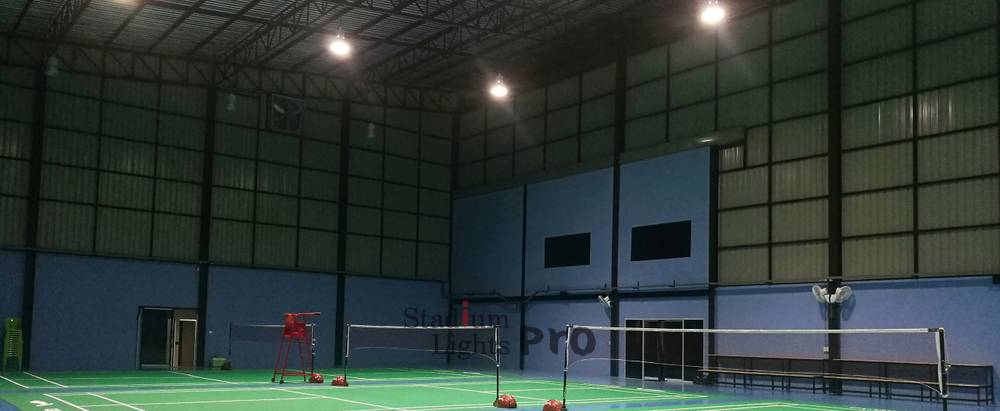
How often should the badminton court lighting be maintained?
The frequency of maintenance for badminton court lighting largely depends on the type of fixtures used and the specific environment. For LED lighting, which is known for its durability and low maintenance needs, a routine inspection every six to twelve months is generally recommended. During these inspections, it is important to clean the fixtures, check for any signs of wear or damage, and ensure that the lights are functioning correctly. Regular maintenance helps to sustain optimal lighting performance and prevent potential issues that could impact the playing conditions. By adhering to a regular maintenance schedule, the lighting system remains effective and reliable over time.
Can lighting be adjusted for different types of badminton events?
Yes, lighting can be adjusted to suit different types of badminton events by incorporating dimming and control systems. These systems allow for modifications in light intensity, enabling the creation of different lighting scenarios tailored to various activities. For example, casual practice sessions might require less intense lighting compared to high-stakes tournaments, which benefit from higher illumination levels for optimal visibility. Adjustable lighting enhances the flexibility of the court, allowing for an improved experience tailored to specific event requirements and contributing to a more professional and adaptable sports environment.
What are the benefits of using LED lighting over fluorescent or halogen lights in badminton courts?
LED lighting offers several advantages over traditional fluorescent or halogen lights, making it an ideal choice for badminton courts. LEDs are highly energy-efficient, consuming significantly less power while delivering the same or greater levels of illumination, which translates to lower energy costs and a reduced environmental footprint. They also boast a longer lifespan, often exceeding 150,000 hours, which minimizes the need for frequent replacements and maintenance. Additionally, LEDs provide consistent light output without flickering, enhancing visual comfort and reducing distractions. They emit minimal heat, contributing to a more comfortable indoor temperature and lowering cooling costs. Furthermore, LEDs are more durable and resistant to shocks and vibrations, making them well-suited for dynamic sports environments. These benefits collectively make LED lighting a superior choice for modern badminton courts, offering both performance and cost advantages.
Conclusion
The evolution of lighting technology, particularly with the adoption of LED solutions, has significantly enhanced the standards for illuminating badminton courts. LEDs provide uniform illumination, optimal lux levels, and energy efficiency, ensuring clear visibility and improved performance for players while also benefiting spectators and broadcasters. Their durability, low maintenance needs, and environmental advantages underscore their suitability for both indoor and outdoor courts. By embracing LED lighting, badminton facilities can achieve better game conditions, reduce operational costs, and support sustainability efforts, aligning with broader environmental goals and contributing to a more enjoyable experience for all involved.

